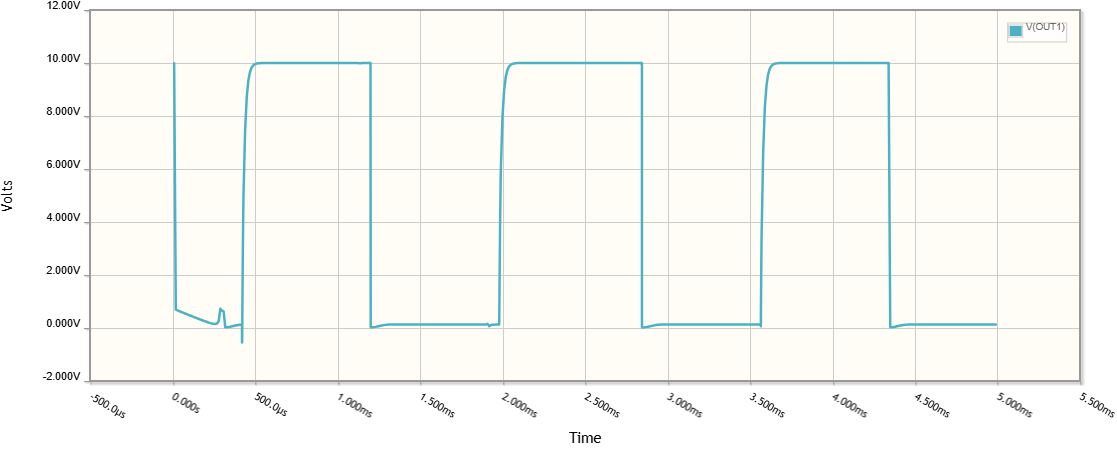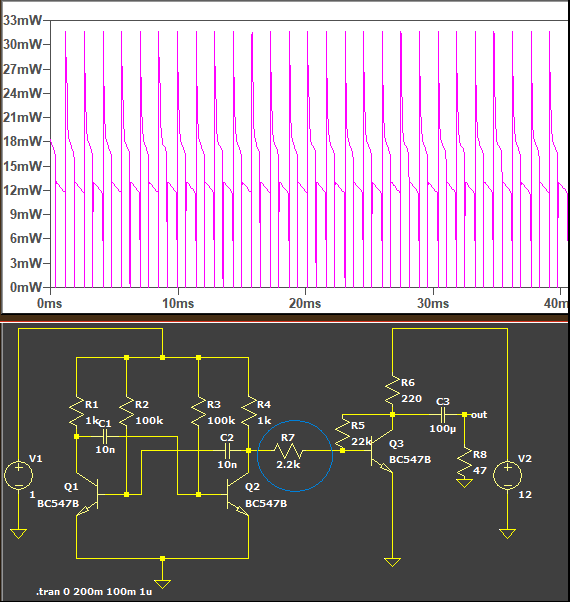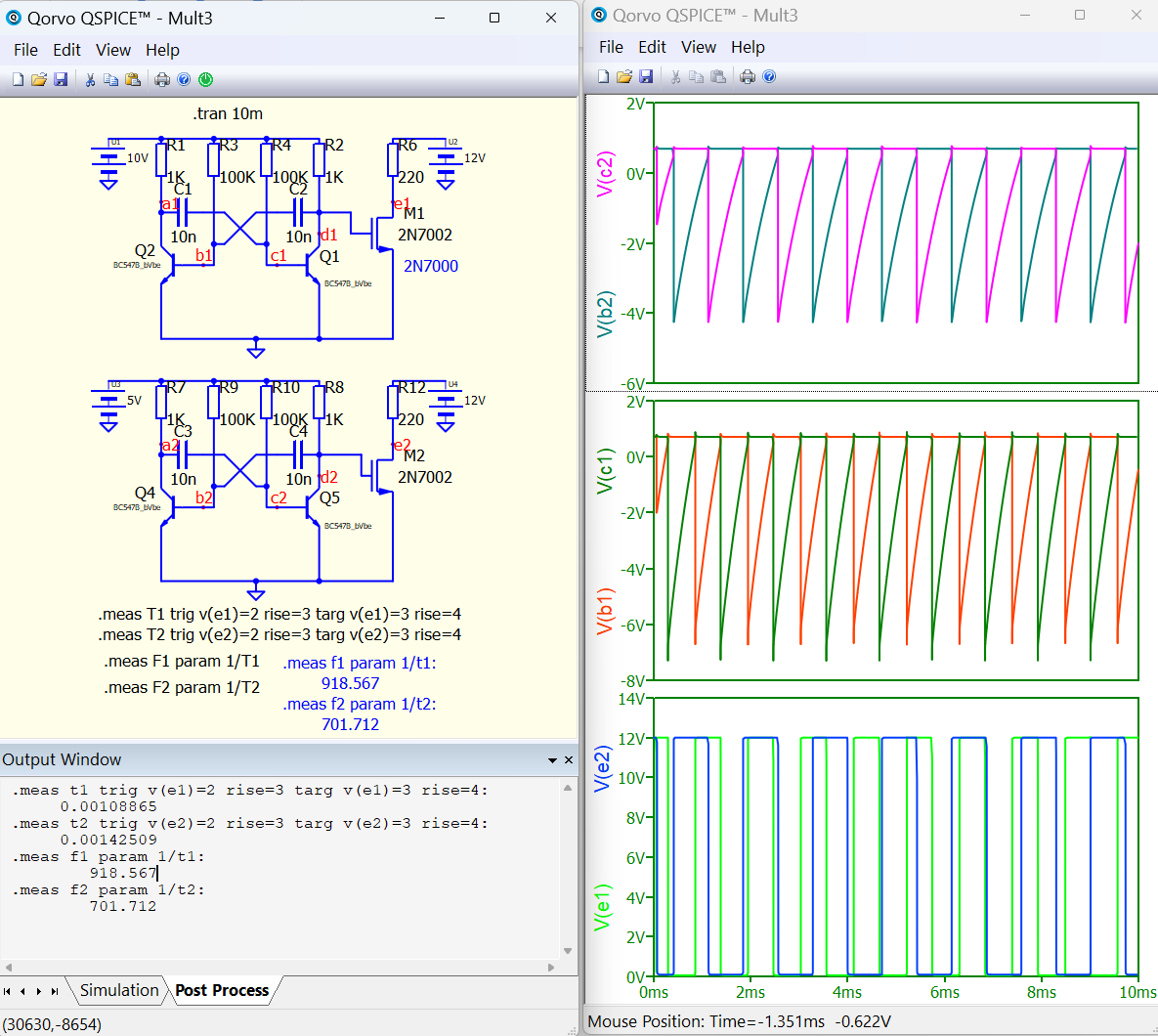I managed to develop an astable multivibrator transistor square wave generator of ~710Hz. This generator will be used as sound for AM radio transmission. The sound must be amplified by an external circuit. The simulation and realization of the generator works fine, but when I want to snatch voltage from this generator at a certain point, it is getting unstable.
I tried putting a capacitor across the voltage source for impedance matching and I could still not figure out why I could not make it work. I don't suppose the failure was just that. Below a picture of the circuit.
How can I extend a basic circuit in conjunction with another one without having to many disadvantages?
Edit:
As demanded below an example:
Edit2:
The amplifier right from the square generator has the following example components: (The values can vary, I just tried with few ones, but had no luck.)
Edit3:
I succeeded to make the circuits working together. I added a 100kohm resistor to the output of oscillator, but it suffered this time from less gain. Why did I do this? I intended to get a good signal output from the oscillator without changing its appearance and further to amplify it. I think I need a multistage amplification method.
Here the circuit:
The .asc file of LTspice:
Version 4
SHEET 1 1560 680
WIRE 256 -144 -64 -144
WIRE 1024 -144 768 -144
WIRE 176 -80 64 -80
WIRE 256 -80 256 -144
WIRE 256 -80 176 -80
WIRE 336 -80 256 -80
WIRE 448 -80 336 -80
WIRE 768 -48 768 -144
WIRE 64 0 64 -80
WIRE 176 0 176 -80
WIRE 336 0 336 -80
WIRE 448 0 448 -80
WIRE 768 48 768 32
WIRE 768 48 656 48
WIRE 848 48 768 48
WIRE 944 48 912 48
WIRE 768 80 768 48
WIRE 64 96 64 80
WIRE 96 96 64 96
WIRE 288 96 160 96
WIRE 368 128 208 128
WIRE 448 128 448 80
WIRE 448 128 432 128
WIRE 496 128 448 128
WIRE 656 128 576 128
WIRE 704 128 656 128
WIRE -64 144 -64 -144
WIRE 1024 144 1024 -144
WIRE 64 176 64 96
WIRE 448 176 448 128
WIRE 176 224 176 80
WIRE 176 224 128 224
WIRE 208 224 208 128
WIRE 208 224 176 224
WIRE 288 224 288 96
WIRE 336 224 336 80
WIRE 336 224 288 224
WIRE 384 224 336 224
WIRE -64 304 -64 224
WIRE 1024 304 1024 224
WIRE 64 368 64 272
WIRE 256 368 64 368
WIRE 448 368 448 272
WIRE 448 368 256 368
WIRE 768 368 768 176
WIRE 256 416 256 368
FLAG -64 304 0
FLAG 256 416 0
FLAG 944 48 out
FLAG 1024 304 0
FLAG 768 368 0
SYMBOL npn 128 176 M0
SYMATTR InstName Q1
SYMATTR Value BC547B
SYMBOL npn 384 176 R0
SYMATTR InstName Q2
SYMATTR Value BC547B
SYMBOL res 48 -16 R0
SYMATTR InstName R1
SYMATTR Value 1k
SYMBOL res 160 -16 R0
SYMATTR InstName R2
SYMATTR Value 100k
SYMBOL res 320 -16 R0
SYMATTR InstName R3
SYMATTR Value 100k
SYMBOL res 432 -16 R0
SYMATTR InstName R4
SYMATTR Value 1k
SYMBOL voltage -64 128 R0
WINDOW 123 0 0 Left 0
WINDOW 39 24 124 Left 2
SYMATTR InstName V1
SYMATTR Value 1
SYMBOL cap 160 80 R90
WINDOW 0 0 32 VBottom 2
WINDOW 3 32 32 VTop 2
SYMATTR InstName C1
SYMATTR Value 10n
SYMBOL cap 432 112 R90
WINDOW 0 0 32 VBottom 2
WINDOW 3 32 32 VTop 2
SYMATTR InstName C2
SYMATTR Value 10n
SYMBOL res 640 32 R0
SYMATTR InstName R5
SYMATTR Value 22k
SYMBOL res 752 -64 R0
SYMATTR InstName R6
SYMATTR Value 220
SYMBOL npn 704 80 R0
SYMATTR InstName Q3
SYMATTR Value BC547B
SYMBOL voltage 1024 128 R0
WINDOW 123 0 0 Left 0
WINDOW 39 24 124 Left 2
SYMATTR InstName V2
SYMATTR Value 12
SYMBOL res 592 112 R90
WINDOW 0 0 56 VBottom 2
WINDOW 3 32 56 VTop 2
SYMATTR InstName R7
SYMATTR Value 100k
SYMBOL cap 912 32 R90
WINDOW 0 0 32 VBottom 2
WINDOW 3 32 32 VTop 2
SYMATTR InstName C3
SYMATTR Value 1µ
TEXT -24 440 Left 2 !.tran 0 200m 100m 1u













but when I want to snatch voltage from this generator at a certain pointwhat do you mean by that? Probing or applying to a load or something else? Finally, why does your power source has 40 Ohms of output impedance? \$\endgroup\$